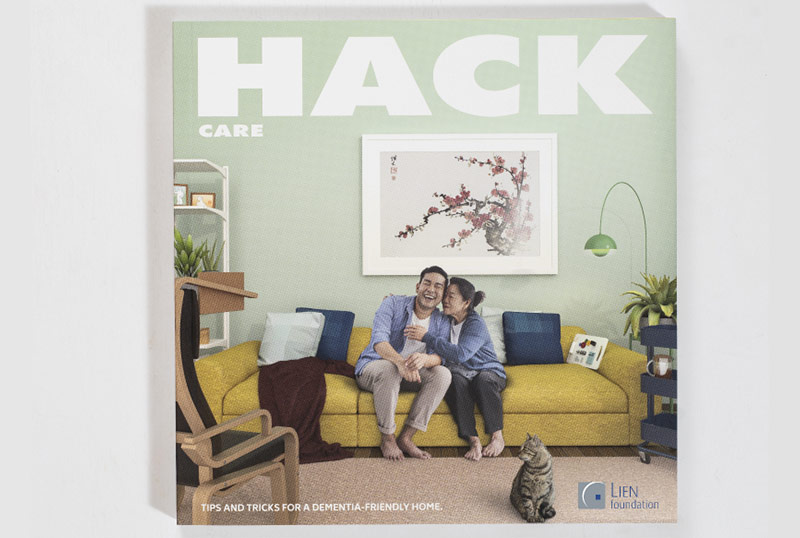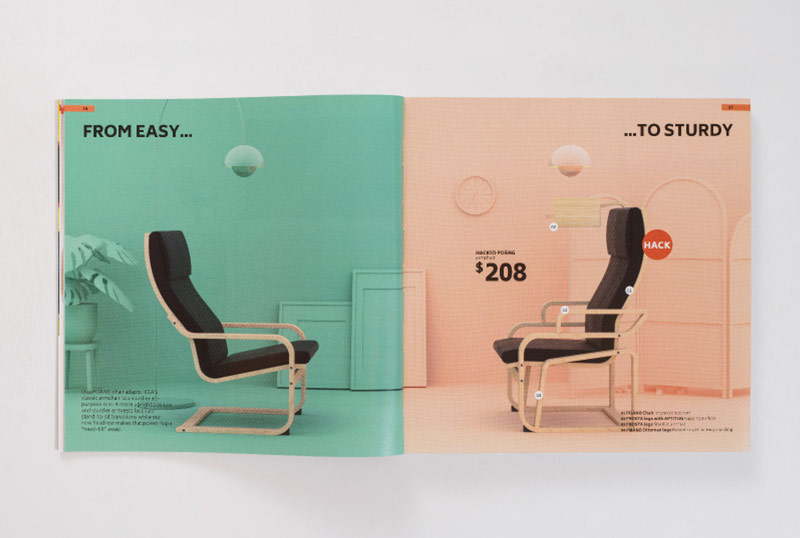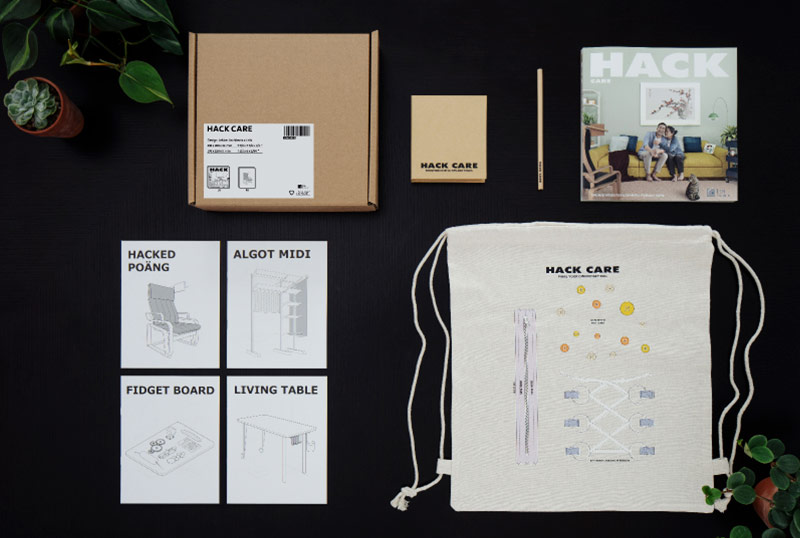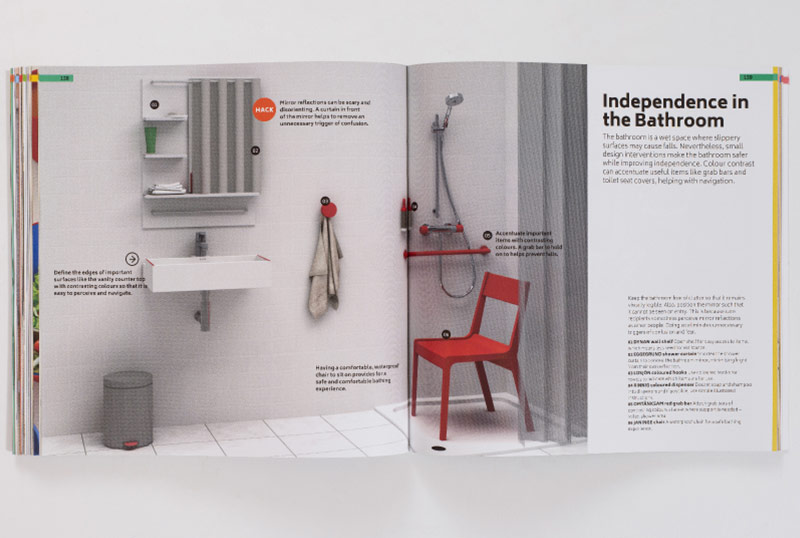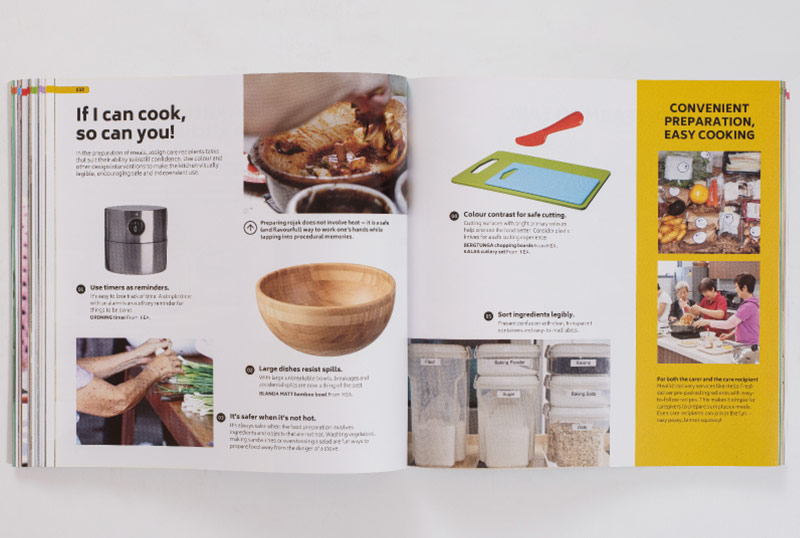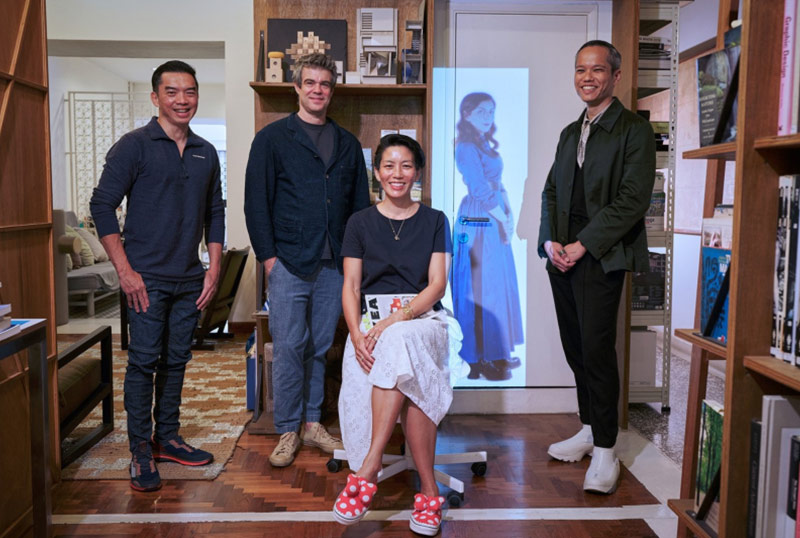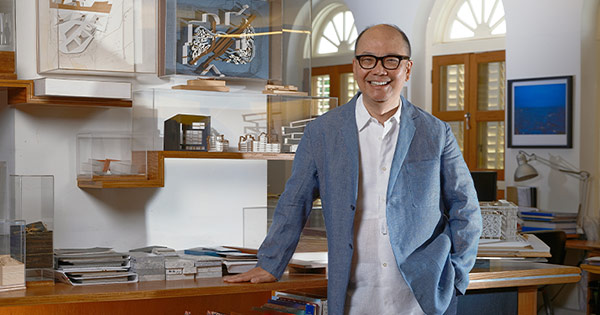* DESIGN OF
THE YEAR 2023
Hack Care: Tips and Tricks for a Dementia-friendly Home
Designer
Lekker Architects
In collaboration with Lanzavecchia + Wai
DISCIPLINE
Digital Design
DESIGN IMPACT
Advancing Singapore Brand, Culture and Community
Making Ground-breaking Achievements in Design
Raising Quality of Life
CONTACT
The blissful families in welcoming domestic settings look right out of a furniture and homeware catalogue. But this is no sales pitch. Instead, Hack Care is a manifesto outlining how anyone can easily turn their home into one that is friendly to persons with dementia.
The 244-page guide by Lekker Architects in collaboration with Lanzavecchia + Wai offers practical tips and tricks for hacking existing furniture and products into solutions that support caring for people with dementia. Adapted with accessories, an armchair transforms into a care station. Switches, locks, and textiles assembled onto a chopping board create an object for the therapeutic activity of fidgeting. Even the considered arrangement of furniture and familiar objects helps, as the guide explains. The many hacks are presented in an easy-to-understand manner for anyone to access and are highly affordable too.
Going beyond a toolkit, Hack Care redefines what design is and who can practice it. Instead of offering fixed solutions, design becomes a process of making and experimenting. It is not just the domain of professionals but also part of everyday human activities. Just as the guide supports caregivers in the creation of a more inclusive home, it opens up access to the world of design.
READ MOREABOUT THE DESIGNER
Lekker Architects is a multidisciplinary practice that explores the social-emotional potentials of design. Co-founders Ar. Ong Ker-Shing and Dr Joshua Comaroff studied environmental design (architecture and landscape) and social science (cultural geography). They combine methods from both areas to search for designs that help people to learn and grow, and form more inclusive kinds of collective relationships.
They are excited by the challenge of catering to the full variety of human bodies, minds, and experiences – not just because it makes lives better, but also because it makes for more compelling design.
Alongside her role as Director of Lekker Architects, Ong is Associate Professor (Practice) and Bachelor of Architecture Programme Director at the National University of Singapore’s Department of Architecture. Comaroff is an Assistant Professor in Urban Studies at Yale-NUS College. His PhD studied haunted landscapes and urban memory in Singapore.
Lekker Architects received a P*DA Design of the Year in 2015 for The Caterpillar’s Cove preschool, the 2020 Singapore Institute of Architects’ Design of the Year for the Quiet Room in the National Museum of Singapore, and the Urban Redevelopment Authority’s Architectural Heritage Award in 2013 for a home and gallery in the Lorong 24A Shophouse Series. Ong and Comaroff are recipients of the Wheelwright Traveling Fellowship from the Harvard Graduate School of Design.
Lanzavecchia + Wai, established in 2010, is an internationally renowned award-winning design studio based in Italy and Singapore. The studio’s work includes research projects for Herman Miller, limited-edition objects, and mass products for brands such as Zanotta, FIAM, Living Divani, LaCividina, Cappellini, De Castelli, Gallotti&Radice, Bosa, Nodus, and Mirage. Lanzavecchia + Wai’s work also includes special commissions for major brands and museums such as Hermès, La Triennale di Milano, Wallpaper*, MAXXI, M+ Hong Kong, Antolini, Tod’s, AgustaWestland, and Alcantara.
The studio’s many accomplishments include being awarded the “Young Design Talent of the Year” by Elle Décor International Design Awards 2014, the Archiproducts Design Award, the Red Dot Award Product Design 2016, and the Innovation in Inclusive Design Practice Award of the Royal College of Art.
READ MOREDESIGNER
Lekker Architects
PHOTOGRAPHER & VIDEOGRAPHER
KHOOGJ
CLIENT
Lien Foundation
COLLABORATOR
Lanzavecchia + Wai
PRINTER
Oxford Graphic Printers Pte Ltd
Insights from the Recipient
Citation
Jury Citation
Hack Care is a timely, important, and highly accessible piece of work that raises public awareness around providing a life of dignity and grace for persons with dementia. Put together with sensitivity and beautifully designed, the book and toolkit offer creative, affordable, and practical ideas for improving the home environment with simple design hacks and innovations. It encourages and empowers caregivers, as well as seeds advocates for inclusive design with every hack.
The Jury commends the project for its powerful message of normalising dementia – positioning it not as a strictly defeating problem but as a prompt to act, adapt, and create a better experience of daily life through ‘hacking’. The Jury also recognises the designers’ attitude of facilitation, rather than prescription, through design – they refer to family caregivers as designers in the project, along with their intention to open a much-needed deeper debate as to how a complex societal issue such as dementia may be tackled.
Hack Care provides a valuable reminder that now more than ever, it is critical to challenge our preconceptions and shape behaviour and thought around dementia, with one in 10 people above the age of 60 years living with the condition in Singapore.
VIEW JURORSNominator Citation
Lee Poh Wah
Chief Executive Officer
Lien Foundation
Two years after the completion of Hack Care, the Lien Foundation can, in our capacity as client, confidently attest to the project attaining outcome-based success.
In work of such a nature, measuring design’s impact is difficult. But the impact of Hack Care can be clearly gleaned from the public’s demand for it. After the original print run of 2,000 copies, which we believed would satisfy the community’s appetite, we had to make a second print run of 1,500. The demand came from exactly the stakeholders who mattered: end users and subject matter experts.
A quarter of the copies were requested by the former (caregivers of persons with dementia), while half were requests from the latter (professional staff from the medical and social services). Caregivers took design into their own hands, putting Hack Care into practice through their experiments with household items to elevate the quality of their loved ones’ lives. Professionals did likewise in eldercare centres and nursing homes, improving lives at a larger scale.
Impact was felt in the design fraternity too, not only locally but also internationally. The project was covered in reputable overseas media such as Wallpaper*, Design Wanted, Elle Décor, and Dezeen. The book inspired designers around the world to look at dementia, an illness that affects millions, through the usually staid vantage point of the domestic.
The project’s success could not have been presumed. The design challenge was complex, and Lekker Architects worked amid painful personal challenges. But the studio dug deep and – on its own initiative – spent three years working on Hack Care alongside its cross-discipline collaborators at industrial design studio Lanzavecchia + Wai, as the vision grew.
This is a special story of designers who reframed adversity as inspiration, using design, satire, and common sense to make a point.
Disclaimer
The ideas in the Hack Care catalogue have been gathered to suggest ways to improvise and expand care for persons with dementia. While every effort has been made to ensure that the hacks contained in the catalogue do not pose any undue health and safety hazards, the Lien Foundation nonetheless urges all readers to exercise their own judgement on the safety, suitability and appropriateness of these ideas to their own respective caregiving situations. Readers are encouraged to do their own research, and to always consult a professional when in doubt.
Hack Care is a social initiative led by the Lien Foundation and is not related to IKEA®, the Inter IKEA Group, or the Ikano Group. All references to IKEA® products are presented for the reader’s convenience only and do not imply IKEA®’s approval of the modification of their products. IKEA®, the Inter IKEA Group, the Ikano Group, and the team behind Hack Care shall not be liable for any product failure, damage or personal injury resulting from the use of the hacks featured in the catalogue.
